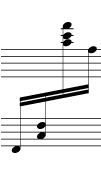Complex Type: harmony
Description
The harmony type is based on Humdrum's **harm encoding, extended to support chord symbols in popular music as well as functional harmony analysis in classical music. If there are alternate harmonies possible, this can be specified using multiple harmony elements differentiated by type. Explicit harmonies have all notes present in the music; implied have some notes missing but implied; alternate represents alternate analyses. The harmony object may be used for analysis or for chord symbols. The print-object attribute controls whether or not anything is printed due to the harmony element. The print-style attribute group sets the default for the harmony, but individual elements can override this with their own print-style values.
Derived By
Restricting xs:anyType
Attributes
| Name | Type | Required? | Default | Description |
|---|---|---|---|---|
| type | harmony-type | No |
|
|
| print-object | yes-no | No |
|
|
| print-frame | yes-no | No | The print-frame attribute controls printing of a frame or fretboard diagram. |
|
| default-x | tenths | No |
|
|
| default-y | tenths | No |
|
|
| relative-x | tenths | No |
|
|
| relative-y | tenths | No |
|
|
| font-family | comma-separated-text | No |
|
|
| font-style | font-style | No |
|
|
| font-size | font-size | No |
|
|
| font-weight | font-weight | No |
|
|
| color | color | No |
|
|
| placement | above-below | No |
|
Content Model
Contains elements as defined in the following table.
| Component | Type | Occurs | Default | Description |
|---|---|---|---|---|
 |
1..1 |
|
||
 |
1..* |
|
||
 |
1..1 |
|
||
| function | style-text | 1..1 |

The function element is used to represent classical functional harmony with an indication like I, II, III rather than C, D, E. It is relative to the key that is specified in the MusicXML encoding. |
|
| root | root | 1..1 |
The root type indicates a pitch like C, D, E vs. a function indication like I, II, III. It is used with chord symbols in popular music. The root element has a root-step and optional root-alter element similar to the step and alter elements, but renamed to distinguish the different musical meanings. |
|
| kind | kind | 1..1 |

Kind indicates the type of chord. Degree elements can then add, subtract, or alter from these starting points. |
|
| inversion | inversion | 0..1 |

The inversion type represents harmony inversions. The value is a number indicating which inversion is used: 0 for root position, 1 for first inversion, etc. |
|
| bass | bass | 0..1 |

The bass type is used to indicate a bass note in popular music chord symbols, e.g. G/C. It is generally not used in functional harmony, as inversion is generally not used in pop chord symbols. As with root, it is divided into step and alter elements, similar to pitches. |
|
| degree | degree | 0..* |

The degree type is used to add, alter, or subtract individual notes in the chord. The print-object attribute can be used to keep the degree from printing separately when it has already taken into account in the text attribute of the kind element. The degree-value and degree-type text attributes specify how the value and type of the degree should be displayed. |
|
| frame | frame | 0..1 |

The frame type represents a frame or fretboard diagram used together with a chord symbol. The representation is based on the NIFF guitar grid with additional information. |
|
| offset | offset | 0..1 |

|
|
 |
0..1 |
|
||
| footnote | formatted-text | 1..1 | The footnote element specifies editorial information that appears in footnotes in the printed score. It is defined within a group due to its multiple uses within the MusicXML schema. |
|
 |
0..1 |
|
||
| level | level | 1..1 | The level type is used to specify editorial information for different MusicXML elements. |
|
 |
0..1 |
|
||
| staff | xs:positiveInteger | 1..1 |

Staff assignment is only needed for music notated on multiple staves. Used by both notes and directions. Staff values are numbers, with 1 referring to the top-most staff in a part. |
|
Referenced By
- Element harmony
Definition
<xs:complexType name="harmony">
<xs:annotation>
<xs:documentation>The harmony type is based on Humdrum's **harm encoding, extended to support chord symbols in popular music as well as functional harmony analysis in classical music.
If there are alternate harmonies possible, this can be specified using multiple harmony elements differentiated by type. Explicit harmonies have all note present in the music; implied have some notes missing but implied; alternate represents alternate analyses.
The harmony object may be used for analysis or for chord symbols. The print-object attribute controls whether or not anything is printed due to the harmony element. The print-frame attribute controls printing of a frame or fretboard diagram. The print-style attribute group sets the default for the harmony, but individual elements can override this with their own print-style values.</xs:documentation>
</xs:annotation>
<xs:sequence>
<xs:group ref="harmony-chord" maxOccurs="unbounded" />
<xs:element name="frame" type="frame" minOccurs="0">
<xsd:annotation>
<xsd:documentation>The frame type represents a frame or fretboard diagram used together with a chord symbol. The representation is based on the NIFF guitar grid with additional information. The frame type's unplayed attribute indicates what to display above a string that has no associated frame-note element. Typical values are x and the empty string. If the attribute is not present, the display of the unplayed string is application-defined.</xsd:documentation>
</xsd:annotation>
</xs:element>
<xs:element name="offset" type="offset" minOccurs="0">
<xsd:annotation>
<xsd:documentation>
</xsd:documentation>
</xsd:annotation>
</xs:element>
<xs:group ref="editorial" />
<xs:group ref="staff" minOccurs="0" />
</xs:sequence>
<xs:attribute name="type" type="harmony-type">
<xsd:annotation>
<xsd:documentation>
</xsd:documentation>
</xsd:annotation>
</xs:attribute>
<xs:attributeGroup ref="print-object" />
<xs:attribute name="print-frame" type="yes-no">
<xsd:annotation>
<xsd:documentation>
</xsd:documentation>
</xsd:annotation>
</xs:attribute>
<xs:attributeGroup ref="print-style" />
<xs:attributeGroup ref="placement" />
</xs:complexType>
